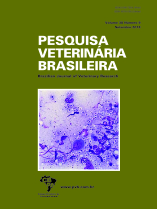 |
|
|
|
Year 2018 - Volume 38, Number 9
|

|
Campylobacter jejuni, Campylobacter coli, Salmonella spp. and Yersinia enterocolitica isolated from wildlife animals of a reabilitation center, 38(9):1838-1843
|
ABSTRACT.- Silveira D.R., Milan C., Ferrasso M.M., Dias P.A., Moraes T.P., Bandarra P.M., Minello L.F. & Timm C.D. 2018. [Campylobacter jejuni, Campylobacter coli, Salmonella spp. and Yersinia enterocolitica isolated from wildlife animals of a reabilitation center.] Campylobacter jejuni, Campylobacter coli, Salmonella spp. e Yersinia enterocolitica isoladas de animais silvestres em um centro de reabilitação. Pesquisa Veterinária Brasileira 38(9):1838-1843. Laboratório de Inspeção de Produtos de Origem Animal, Departamento de Veterinária Preventiva, Universidade Federal de Pelotas, Campus Capão do Leão, prédio 34, Pelotas, RS 96010-900, Brazil. E-mail: debora.rsilveira@hotmail.com
Wild animals can transmit pathogenic bacteria to human and domestic animal’s health. Some bacteria, such as Campylobacter jejuni, Campylobacter coli, Yersinia enterocolitica and Salmonella enterica, cause diseases in humans and can contaminate domestic and wild animais. The Núcleo de Reabilitação da Fauna Silvestre of Universidade Federal de Pelotas (Nurfs-UFPel) attend a specific regional demand of wildlife in Brazil. The aim of this paper was to identify the presence of these pathogenic bacteria in wild animals in rehabilitation. Stool samples were collected using sterile swabs from 34 birds, 16 mammals and 23 reptilian that were housed at Nurfs. Of the 73 collections, Y. enterocolitica was isolated from four (5.48%) of two birds, one mammal and one reptile. Salmonella and Campylobacter were not isolated. The molecular profile of bands of Y. enterocolitica identified in rep-PCR had differences. These results indicated that the isolates did not have a recent common origin. Pantherophis guttatus, Didelphis albiventris, Turdus rufiventris and Vanellus chilensis could shelt Y. enterocolitica and eliminate the bacteria in stool, offering risk of dissemination of these microorganisms in the environment with possible contamination of humans and other animals. |
| |
|
|
| |
|
 |